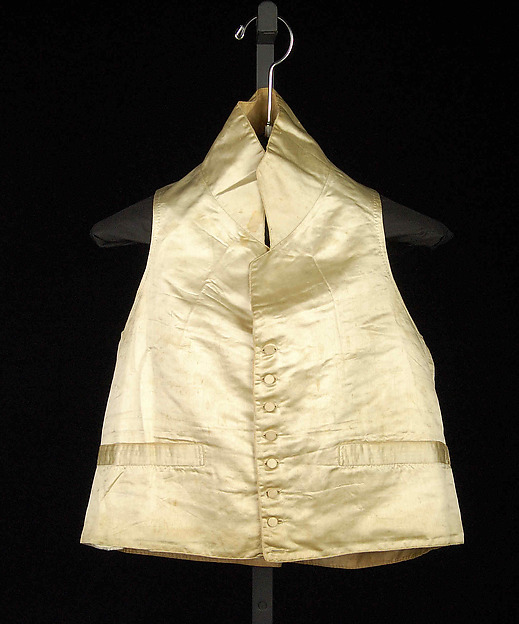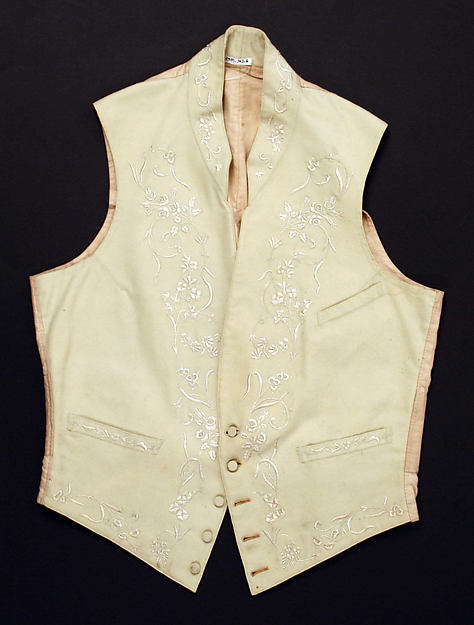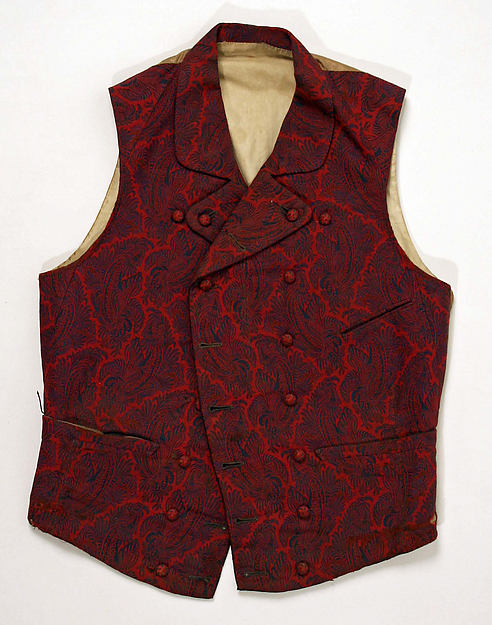Apart from certain stylistic keys, I've always had a harder time dating men's clothing. It's just not as interesting to me, so I haven't taken the time to really study dated extant pieces and images and improve my skills. But lately I've come across more undated waistcoats while cataloguing - it's become something that I need to work on. And how better than by putting together a blog post?
At the beginning of the century, fashionable waistcoats were cut straight across at the bottom to match fashionable coats, although the vests often protruded slightly below the waistline of the coat. High collars, also matching the coats, would cover the sides of the shirt collar that extended up to the jawline. Both coats and vests could be single- or double-breasted, generally with self-covered buttons. While coat lapels were generally wide, waistcoat lapels were somewhat narrower.
Toward the end of the first decade of the century, the openings above the buttoned areas in both tended to be shorter and narrower, and around 1812 they began to appear sometimes almost fastened up to the neck. The standing collar was much shorter by this point, no longer covering the shirt. (In formal dress, waistcoats retained the longer, angled hems and types of embroidery that had been worn in the later eighteenth century.)
Around 1814-1815, the fashionable male figure began to have a distinctly nipped-in waist, which could be reflected in the cut of the waistcoat or in padding added to the chest. Emphasizing this, they would generally be buttoned only at the bottom, the shirt's
jabot bursting from the opening. The waisted effect increased and continued through the 1820s, though the fashionable waist was located lower toward the end of that decade.
At first the trend of only buttoning waistcoats around waist level had no effect on cut, but at the end of the 1810s the construction changed: buttons and buttonholes were placed only on the lower half or two-thirds of the opening, and the front edges themselves might be cut on a curve so as to keep the lengthened lapels narrow all the way up, with only a slight notch.
 |
| "Waistcoat of gros de Naples with pearl buttons, lined with a contrasting color," Petit Courrier des Dames, ca. 1835; NYPL 802030 |
The bottom edges of the vest remained horizontal for most of this time; around the middle of the 1820s, they were cut with a slight curve to create separate points at the opening below the buttons when worn. As the puff of the chest was emphasized more at the end of the decade and the front edges were curved more, the lowest button was left unbuttoned and the points were then larger. However, these points didn't last very long - by the very early 1830s, it was more common for the fully-closed vest to end in a gradual slope to one point, or simply a straight line, the latter especially if the waistcoat were double-breasted.
Very little change occurred over the rest of the 1830s, but the unnotched shawl collar began to be more prevalent at the end of the 1830s; the angled breast pocket seems to have begun to appear between 1840 and 1845. Lower points without buttons reappeared after 1840 as well, whether single- or double-breasted, and while very narrow lapels remained in use wide ones were seen as well, more and more frequently toward the end of the decade.
Early in the 1850s, the points dropped out of favor for a flat lower edge: at first with some space below the lowest button to create two wide points, then a completely straight line around 1855. While a deep opening to reveal the shirtfront remained in use, especially in evening dress or at home, for day dress a higher neckline became more common around 1855 as well. By the end of the decade, when buttoned high a waistcoat could have no lapels at all.
The greatest change in the mid-1850s was that a pinched male waist was no longer fashionable. The chest was still to be rounded, still enhanced with padding, but the defined difference between waist and hips was smoothed out. Vests less commonly flared below the waistline.
In the early 1860s, slight points reappeared at the lower edge of waistcoats, and the shawl collar began to be set aside in favor of either no lapels or notched and pointed ones.
Around this point, it becomes very difficult to find images of men's waistcoats, as it was common to keep the coat fully buttoned, or just fastened at the top, during the day. Magazines aimed at gentlemen and their tailors, however, such as the
Gentleman's Magazine of Fashion, made an effort to show or at least describe them, and it's clear that the era of the three-piece suit had begun: many waistcoats were made in the same fabric as a coat and trousers. When not made to match, vests were generally plain, not in the bright patterns and colors of prior decades. Their forms stopped changing, pointed lower edges and no (occasionally notched) lapels remaining most common through the early twentieth century, though double-breasted vests with flat lower edges were also worn. (A second breast pocket seems to have been frequently added after the turn of the century.)
Formalwear fossilized to an even earlier shape, with shawl collars and deep necklines. White and black fabrics were the only ones used - for, respectively, white and black tie.







Oooh, this is a great overview, thanks! I'm super-fuzzy on menswear myself (I guess that's cause I don't have anyone to put in it, haha) but I still like learning about it!
ReplyDeleteAnd that's interesting to me, that I really stop paying attention to menswear right around where they stop having fun-colored waistcoats, apparently. I guess I like my mens in colorful clothes...
You're welcome! Maybe someday we will both outfit some guys in waistcoats and trousers. :D
DeleteI had a vague idea before of the trends, but they were based on some misconceptions and stereotypes, and it's nice to get it all straightened out. We have similar tastes, as you can see by my trailing off! (Which has as much to do with my Big Disappointment, but also things get very samey and blah.)
Very interesting and informative article!
ReplyDeleteDo you happen to have any ideas as to why there were the changes you mention ~1860's? Why the 3-piece suit became A Thing?
Thanks for sharing the best information and suggestions, it is very nice and very useful to us. I appreciate the work that you have shared in this post. Keep sharing these types of articles here.Custom Mens Suits Vancouver BC
ReplyDeleteHelpful article! Which you have shared here about nehru jacket. It's useful for me but also good for others who are searching for this information about nehru jacket. Thanks for giving me information like this. nehru jacket for men online in India
ReplyDeleteI just wanted to say this is an elegantly composed article as we have seen here. I got some knowledge from your article and also it is a significant article for us. Thanks for sharing an article like this.Cinderella Dresses Los Angeles
ReplyDeleteWow! Thank you! I constantly wanted to write on my site something like that. Can I take a portion of your post to my website? Best Trousers for Men service provider.
ReplyDeleteYour information is really amazing. Definitely those things are very useful for us. I'm impressed with your article. please share more information with us. suit design online
ReplyDelete
ReplyDeleteWonderful article, Which you have shared about the service. Your article is very important and I really enjoyed reading it. Get for more information Caps for Men
It’s actually a great and helpful piece of info. I’m happy that you just shared this helpful info with us. Please keep us informed like this. Thanks for sharing! Best trending t shirts for men service provider.
ReplyDeleteThis is really a good source of information, I will often follow it to know more information and expand my knowledge, I think everyone should know it, thanks Best Mexico Green Tracksuit service provider.
ReplyDelete